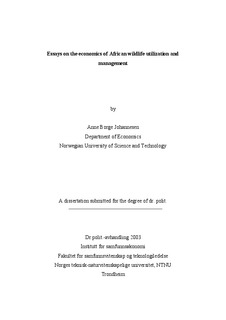| dc.contributor.author | Johannesen, Anne Borge | nb_NO |
| dc.date.accessioned | 2014-12-19T14:24:41Z | |
| dc.date.available | 2014-12-19T14:24:41Z | |
| dc.date.created | 2003-04-29 | nb_NO |
| dc.date.issued | 2003 | nb_NO |
| dc.identifier | 123783 | nb_NO |
| dc.identifier.isbn | 82-471-5175-8 | nb_NO |
| dc.identifier.uri | http://hdl.handle.net/11250/264959 | |
| dc.description.abstract | The present thesis addresses the performance of wildlife management systems in Africa in general and in the Serengeti-Mara ecosystem in Tanzania in particular. The essays to be presented were initially motivated by the failure of the traditional management of protected areas and the observed difficulties regarding the design of wildlife management systems based on local participation. The thesis provides, based on economic incentives, an explanation of the failure of the traditional protected area management. In addition, the observed broad range of management systems calls for studies of different property rights regimes. In addition, founded on both theoretical and empirical analyses, three essays discuss under what conditions programmes based on local participation will succeed in promoting wildlife conservation.
The methodology of the papers is based on bio-economic modelling and represents all classes of models reviewed in section 4.2. The starting point of every model is a protected area surrounded by a local community. The property rights to wildlife are legally well defined and held by the State or the park manager appointed by the State, i.e. a state property regime. The State offers the local people user rights to wildlife in chapter 2, while, hunting performed by the local people in absence of property rights is considered illegal in chapter 3 to 5.
The main contribution of the papers is to explore the incentives of the local people to exploit wildlife, and how these are affected by different policies. Throughout the papers the local people are considered the only active agent, and, hence, the park manager is passive. This means that the implemented policies are treated as exogenous in the models. The effect of the various management strategies is therefore analysed in the framework of partial equilibrium models. | nb_NO |
| dc.language | eng | nb_NO |
| dc.publisher | Fakultet for samfunnsvitenskap og teknologiledelse | nb_NO |
| dc.relation.haspart | Johannesen, Anne Borge. Protected areas, wildlife conservation, and local welfare. ECOLOGICAL ECONOMICS. 62(1): 126-135, 2007. | nb_NO |
| dc.relation.haspart | Johannesen, Anne Borge; Skonhoft, A.. Property rights and natural resource conservation. A bio-economic model with numerical illustrations from the Serengeti-Mara ecosystem. ENVIRONMENTAL & RESOURCE ECONOMICS (The original publication is available at www.springerlink.com). 28(4): 469-488, 2004. | nb_NO |
| dc.relation.haspart | Johannesen, Anne Borge. Designing integrated conservation and development projects (ICDPs): illegal hunting, wildlife conservation, and the welfare of the local people. ENVIRONMENT AND DEVELOPMENT ECONOMICS. 11(2): 247-267, 2006. | nb_NO |
| dc.relation.haspart | Johannesen, Anne Borge. Wildlife conservation policies and incentives to hunt: an empirical analysis of illegal hunting in western Serengeti, Tanzania. ENVIRONMENT AND DEVELOPMENT ECONOMICS. 10(3): 271-292, 2005. | nb_NO |
| dc.subject | Economics | en_GB |
| dc.subject | SOCIAL SCIENCES: Business and economics: Economics | en_GB |
| dc.title | Essays on the economics of African wildlife utilization and management | nb_NO |
| dc.type | Doctoral thesis | nb_NO |
| dc.source.pagenumber | 187 | nb_NO |
| dc.contributor.department | Norges teknisk-naturvitenskapelige universitet, Fakultet for samfunnsvitenskap og teknologiledelse | nb_NO |
| dc.description.degree | dr.polit. | nb_NO |
| dc.description.degree | dr.polit. | en_GB |
